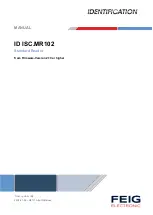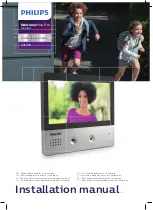
2
OH/IR
LA
I2
I1
4
3
2
1
1
2
5
GB
INSTALLATION
INSTRUCTIONS
OH/IR is equipped with an IR receiver
for remote controls and two digital in-
puts.
The module must be used in CAME
home automation systems.
The receiver is operated from the OH/
IRTX1 remote control, from remote
controls with NEC coding or universal
remote controls capable of learning
and replicating the commands of the
OH/IRTX1 remote control.
Once the device has been connected
to the CAME home automation BUS,
the inputs can manage contacts (for
instances, buttons).
The unit can be installed in boxes with
DIN rails (EN 50022), fig. 3. It can also be
located in the base of a recessed box
with three or more modules (fig. 4).
In this case, there must be at least 18
mm between the bottom of the box
and the fruit connector. If mains voltage
is present (230V AC) in the recessed box,
you will need to use the wire sheath
provided on the end section of the BUS.
c
Attention:
The device may be damaged if installed
near cables that carry current at 230V AC.
i
There is no galvanic separation
between the supply voltage of the con-
tacts and the voltage on the BUS.
System characteristics
• Connection topology: free.
• BUS line specifications:
The cable provided must be a twisted
pair, shieldless and non-polarized.
The Home Automation BUS NH-C1D
(cod. 67900101) can be used, or a twist-
ed pair telephone line in accordance
with standard CEI 46-5 with the follow-
ing characteristics:
- conductor section 0,28 mm
2
;
- typical impedance from 90 to 120Ω;
- capacity at 800 Hz from 60 to 130 nF/km;
- electrical resistance at 20 °C max
67 Ω/km.
It is important to note that if you use un-
insulated telephone twisted pair compli-
ant with standard CEI 46-5, due to the
voltages involved it must be placed in
dedicated ducts, i.e. not used for wiring
at 230 V AC. Also, in the recessed box, it
is necessary to use the wire sheath pro-
vided on the end section of the BUS.
Function of terminals
(fig. 1)
LA
BUS line
1 common contacts
2
3
4
inputs for IR receiver
(follow the order of wiring fig. 1)
I1 Digital input
I2 Digital input
Function of SERVICE button (SW)
Function of SERVICE button (fig.1)
Allows identification of the device in
programming phase (see software in-
structions).
Function of Service LED
(fig. 1)
This comes on each time the SERVICE
button is pressed.
Other signals
-
Always on
: faulty
-
Always off
(even after pressing but-
ton SERVICE): faulty, or BUS not con-
nected.
Troubleshooting
In case of malfunction, check for proper
connection by pressing the service push
button SW (if the LED is off, it means
that their is no connection or the unit
is faulty).
If the unit is faulty, follow the replace-
ment procedure as established by the
system.
Technical characteristics
• Dimensions:
low-profile 1-unit module for installa-
tion on DIN rail (fig. 2).
• Power supply:
from BUS line.
• Contact input (I1, I2):
without cross passage of current or
voltage at ends.
• Maximum distance between the
buttons, sensors, etc. and the input
devices:
20 metres. The distance is halved to
10 metres if the insulated input wires
are flanked by mains conductors.
• Working temperature range:
from 0 °C to +35 °C.
• Maximum relative humidity in
operation:
93% without condensation
DISPOSAL
- Do not litter the envi-
ronment with packing material: make
sure it is disposed of according to
the regulations in force in the count-
ry where the product is used. When
the equipment reaches the end of its
life cycle, take measures to ensure it is
not discarded in the environment. The
equipment must be disposed of in
compliance with the regulations in for-
ce, recycling its component parts whe-
rever possible. Components that qualify
as recyclable waste feature the relevant
symbol and the material’s abbreviation.
CE Declaration -
CAME S.p.A. declares
that this device complies with directive
2004/108/EC. Original upon request.
D
INSTALLATIONS-
ANLEITUNG
OH/IR verfügt über einen IR-Empfänger
für Fernbedienungen sowie über 2 di-
gitale Eingänge.
Das Modul darf nur mit Domotik-Syste-
men von CAME verwendet werden.
Der Empfänger ist geeignet für die
Fernbedienung OH/IRTX1 sowie für
Fernbedienungen mit NEC- oder Uni-
versal-Code, die mit den Kommandos
der Fernbedienung OH/IRTX1 pro-
grammiert werden können und in der
Lage sind, diese Kommandos auszu-
führen.
Sobald das Gerät an das Domotik-BUS
CAME angeschlossen ist, können über
die Eingänge Kontakte (z.B. die der Tas-
ten) gesteuert werden.
Das Gerät kann in Kästen mit DIN-Schie-
ne (EN 50022) installiert werden, Abb.
3. Es kann im Boden eines UP-Kastens
mit 3 oder mehreren Modulen unterge-
bracht werden (Abb. 4).
In diesem Fall müssen zwischen Gehäu-
seboden und dem Kontaktgeber min-
destens 18 mm Platz bleiben. Bei Netz-
spannung (230V AC) im UP-Kasten muss
die beiliegende Kabelummantelung am
letzten Abschnitt der BUS-Leitung ver-
wendet werden.
c
Achtung:
Wenn die Vorrichtung in der Nähe der
stromführenden 230V AC - Kabel mon-
tiert wird, kann sie beschädigt werden.
i
Zwischen der Versorgungsspan-
nung der Kontakte und der Spannung
auf der BUS-Leitung gibt es keine galva-
nische Trennung.
Anlagenmerkmale
• Anschlussart: frei.
• Beschreibung der BUS-Leitung:
Das vorgesehene Kabel muss aus einer
ungeschirmten und ungepolten Tele-
fonschleife bestehen.
Es ist der CAME Home automation
NH-1CD (Cod. 67900101) oder die
Telefonschleife gemäß der Norm CEI
46-5 mit folgenden Eigenschaften ein-
setzbar:
- Leiterquerschnitt 0,28 mm
2
;
- typische Impedanz von 90 bis 120Ω;
- Kapazität bei 800 Hz von 60 bis 130
nF/km;
- elektrischer Widerstand bei 20 °C max.
67 Ω/km.
Bei der Verwendung der nicht isolierten
Telefonschleife nach der Norm CEI 46-5
für die vorhandene Spannung muss
unbedingt beachtet werden, dass die-
se in geeigneten Kanälen verlegt wird,
die nicht für die Verkabelung mit 230
VCA Spannung benutzt werden dürfen.
Im UP-Kasten muss auf dem letzen Ab-
schnitt der BUS-Leitung die beiliegende
Kabelummantelung benutzt werden.
Belegung der Klemmen
(Abb. 1)
LA
BUS-Leitung
1 gemeinsame Kontakte
2
3
4
Eingänge für IR-Empfänger
(Befolgen Sie die Reihenfolge der
Verkabelung Abb. 1)
I1 Digitaleingang
I2 Digitaleingang
Funktion der Taste SERVICE (SW)
(Abb. 1)
Erlaubt die Kennung der Vorrichtung
bei der Programmierung (siehe Bedie-
nungsanweisung der Software).
Funktion des LED-Service
(Abb. 1)
Die LED schaltet sich bei jeder Betäti-
gung der Taste SERVICE ein.
Weitere Meldungen
Altre segnalazioni
-
Immer eingeschaltet
: defekt.
-
Immer ausgeschaltet
(auch nach
Drücken der Taste SERVICE): defekt
oder BUS nicht angeschlossen.
Fehlersuche
Im Falle einer Betriebsstörung des
Moduls ist der korrekte Anschluss zu
überprüfen. Hierzu die Servicetaste SW
drücken (LED aus: kein Anschluss vor-
handen oder Gerät defekt).
sollte das Gerät defekt sein, der vom
System vorgesehenen Verfahrensweise
folgen.
Technische Merkmale
• Abmessungen:
Modul mit 1 DIN-Einheit für DIN-
Schiene (Abb. 2).
•
Versorgung:
über BUS-Leitung.
•
Kontakteingang (I1, I2):
ohne Stromdurchlauf oder Spannung
an den Enden.
•
Maximaler Abstand der
Tasten,Fühler, usw. von den Ein-
gangsvorrichtungen:
20 Meter. Der
Abstand wird auf 10 Meter halbiert,
wenn die entsprechend isolierten
Eingangskabel entlang der Netzleiter
verlaufen.
• Betriebstemperatur:
von 0 °C bis +35 °C.
• Maximale Feuchtigkeit im Betrieb:
93% ohne Kondensatbildung.
ENTSORGUNG -
Vergewissern Sie sich,
dass das Verpackungsmaterial gemäß
den Vorschriften des Bestimmungslan-
des ordnungsgemäß und umweltge-
recht entsorgt wird. Das nicht mehr
benutzbare Gerät ist umweltgerecht zu
entsorgen. Die Entsorgung hat den gel-
tenden Vorschriften zu entsprechen und
vorzugsweise das Recycling der Geräte-
teile vorzusehen. Die wiederverwert-
baren Geräteteile sind mit einem Mate-
rialsymbol und –zeichen versehen.
Herstellererklärung CE -
Die CAME Spa
erklärt, dass dieses Gerät mit der Richt-
linie 2004/108/EG konform ist. Original
auf Anfrage.






















